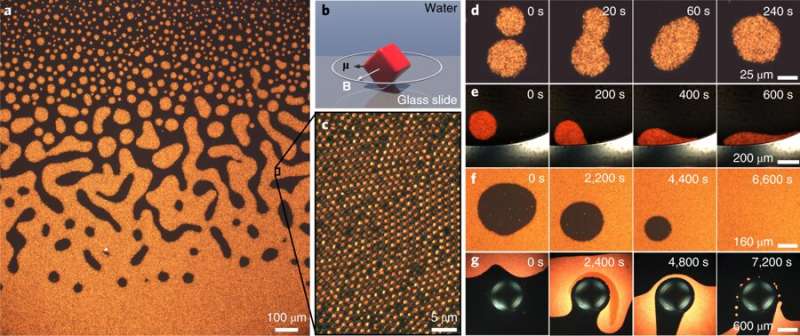September 17, 2019 report
Two-dimensional chiral fluid mostly follows hydrodynamics theories

A team of researchers with members from several institutions in the U.S. and one in France has created a two-dimensional chiral fluid that mostly follows hydrodynamics theories. In their paper published in the journal Nature Physics, the group describes their fluid, many of its properties, and the ways it differs from other fluids. Alexander Abanov with Stony Brook University has published a News & Views piece in the same journal issue outlining the work done by the team.
Scientists have long sought to understand the properties of fluids. Doing so has not only led to equations that describe its behavior, but theories that describe how other types of fluids that do not even exist might behave. In this new effort, the research team has created a type of fluid that until now, was only theory.
The fluid created by the researchers consisted of millions of very small hematite colloidal cubes, each with a magnetic moment. To make them behave as a fluid, a magnet was rotated around them. The result was a two-dimensional chiral fluid. Abanov notes that the fluid was considered to be chiral because the particles in the fluid that flowed clockwise were not exactly the same as those that flowed counterclockwise. The researchers explain that the point of creating the chiral fluid was to test theories such as those that apply to invariance under parity and time reversal, imposed under a rotational constituent. Such a fluid, they note, removes the constraints of a traditional fluid, and has been the subject of much research. Their effort takes the work to the next level by physically demonstrating many of its properties.
In studying their fluid in action, the researchers found that dissipative viscous "edge-pumping" was a general mechanism in chiral hydrodynamics—it led to unidirectional surface waves, which created instabilities—something not found in regular fluids. They also found that spectral measurements of their fluid showed evidence of Hall viscosity, a theorized property of chiral fluids, and that it was smaller than shear viscosity. Abanov notes that the effect of the Hall viscosity turned out to be similar to surface tension, though there were differences in wavelength dependence.
More information: Vishal Soni et al. The odd free surface flows of a colloidal chiral fluid, Nature Physics (2019). DOI: 10.1038/s41567-019-0603-8
Journal information: Nature Physics
© 2019 Science X Network





















